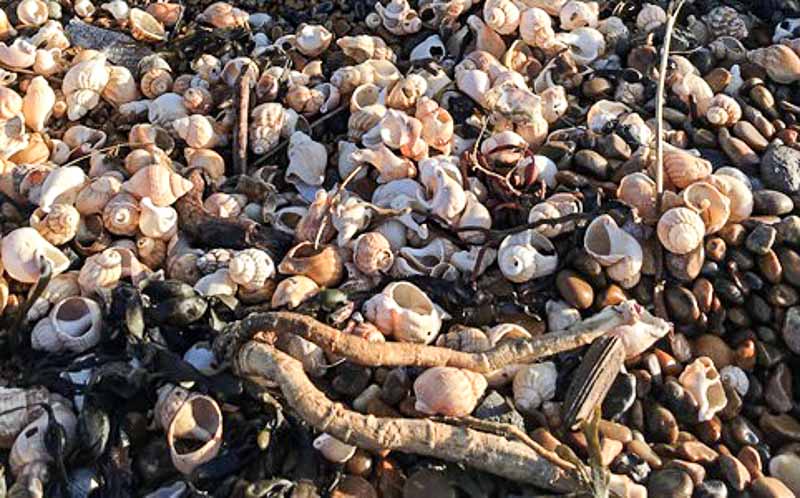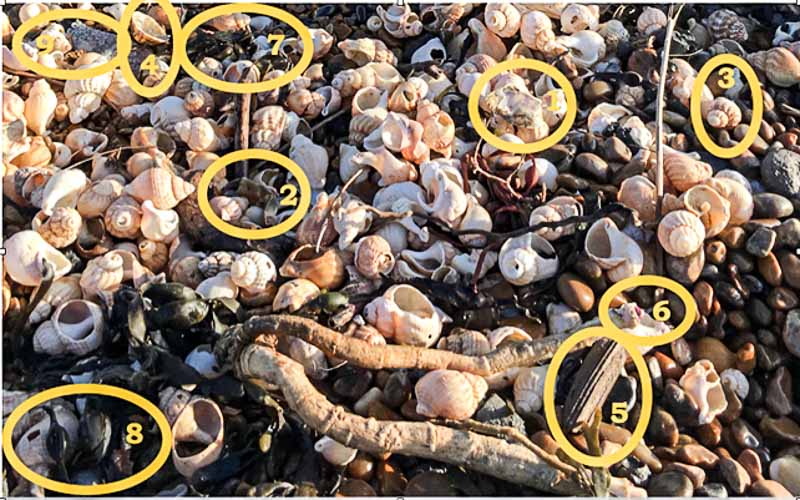by Kate Osborne
 This photograph was taken around the winter solstice in 2017. During the last lockdown I found myself studying it intensely longing for the day when I could go back to the beach. Beach-combing may appeal in sunnier weather but it’s the winter winds and storms that cast up the most treasure.
This photograph was taken around the winter solstice in 2017. During the last lockdown I found myself studying it intensely longing for the day when I could go back to the beach. Beach-combing may appeal in sunnier weather but it’s the winter winds and storms that cast up the most treasure.
How many treasures can you find? – There are at least eight.
1. Overturned shore crab shell
2. Edible crab claw
3. Common whelk shell
4. Limpet
5. Driftwood
6. Sea kale root
7. Toothed rack
8. Egg rack
You can find the answers at the end of this article.
Enlarged photos are shown below to make it easier to spot the treasures.



 There is evidence of just 2 of the over 50 species of crab to be found in the UK. The shell of a shore crab (1) is overturned, likely moulted rather than eaten. The crab will grow until it is almost bursting out of its shell, then “unzip” itself out of its shell, hiding somewhere until its soft skin hardens into a new shell. There is also the distinctive black tipped claw (2) of the edible crab.
There is evidence of just 2 of the over 50 species of crab to be found in the UK. The shell of a shore crab (1) is overturned, likely moulted rather than eaten. The crab will grow until it is almost bursting out of its shell, then “unzip” itself out of its shell, hiding somewhere until its soft skin hardens into a new shell. There is also the distinctive black tipped claw (2) of the edible crab.
The white common whelk shell (3) dominates this strandline. Although not appearing in the photograph, look out for its bundles of egg cases resembling a clump of Rice Krispies. The first few of these eggs to hatch out will cannibalise their siblings as they are the first available food source! When wet the egg cases become soft sponges which sailors would use to wash, so they are also known as sea wash balls.
Limpets (4) are another common shell. They have a home “scar” on a rock which their shell fits; they may even grind their shell to make the perfect accommodation. They return “home” as the tide goes out, and as it comes back in and covers them, they graze on algae growing on the rocks. Did you know that limpet teeth are the strongest natural substance in the world? Yes, stronger even than diamonds!
The driftwood (5) in the photo shows markings on its left hand side of the shipworm, destroyer of wooden boats and known as “calamitas navium” by Linnaeus. Not a worm at all but a bivalve with greatly adapted shells and an abnormally elongated body. The shipworm leaves perfectly circular chalk lined tubes behind as it eats its way through the wood. The chalk is actually the shipworm’s excrement which helps protect its soft, vulnerable body which would never fit into the modified shells. Shipworm burrows never meet, they seem able to detect the presence of a neighbour and turn to avoid them.
Driftwood and seaweed are both critical components of the beach life cycle. Please leave them on the beach. They provide food, shelter and habitat for tiny creatures, which in turn are a food source for spiders, beetles and other bugs, some unique to shingle beaches. These, in their turn, are food for smaller mammals and birds. And, as the seaweed and driftwood decompose they provide just enough humus in the stony desert to allow the seeds of shingle plants to germinate.
You can also see a dislodged sea kale root (6) and its tiny, magenta tip emerging at the end of one of the roots. Sea kale pushing through the shingle stones in spring is the most extraordinary sight. Bright purply-red where you would expect green, eventually fading to the glaucous, leafy mounds of sea cabbage. Sea kale adapts to the dry, windswept, salty conditions with thick, fleshy roots that can extend up to two metres into the shingle, absorbing and holding on to any precious fresh water.
Again, just 2 of the over 700 species of seaweed in the UK can be seen. The serrated or toothed wrack (7) has been washed up in a clump from the lower shore. It spends most of its time underwater providing habitat for marine animals and encrusting tube worms. The air bladders (8) of the egg wrack allow it to float upwards in the water, closer towards the sunlight which it uses to photosynthesise. This is one of the longer lived seaweeds and is possible to age, as it only grows one new air bladder along its length each year. Someone found a piece of egg wrack on one of my Felixstowe beachcombs that was thirteen years old!
And of course there’s the inevitable plastic trash, in this case a piece of bubble wrap (9), but happily there is far more treasure than trash in this photograph.
Please beachcomb sustainably. Take away as much rubbish and sea glass/pottery as you like but everything else belongs on the beach. Our shingle beaches are a complex & fragile habitat – the plants & animals that live there need that driftwood, shell or stone far more than you. Thank you!
Kate Osborne
Kate Osborne is the founder of Beach Bonkers, using beachcombing to inspire people about Suffolk’s shingle beaches. She does this by leading guided beachcombs, giving talks and taking the beach to people. See www.beachbonkers.org.uk for details or call Kate on 0751 255 7200

